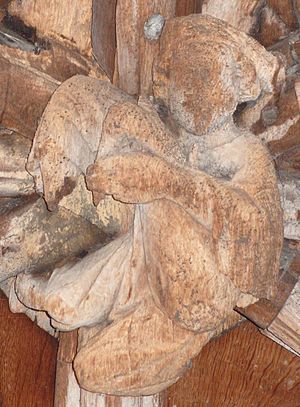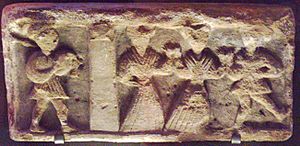Lincolnshire bagpipes facts for kids
It's not totally clear if the Lincolnshire bagpipes were a special type of bagpipe found only in Lincolnshire, England. Or maybe it just meant that bagpipes were super popular there! Records show bagpipes were linked to Lincolnshire as far back as 1407. But it's hard to find solid proof that a unique "Lincolnshire" version of the bagpipe ever existed. Even without proof of a special instrument, people in Lincolnshire clearly loved their bagpipes.
Over time, bagpipes became less common in Lincolnshire. By 1850, they were mostly gone. A farmer named John Hunsley from Manton kept playing them until around 1851-1861. In 1984, a pipemaker named John Addison from South Somercotes started looking into whether a unique "Lincolnshire bagpipe" truly existed. By 1989, he had built a set of pipes based on the old clues he found.
What They Were Like
One of the earliest mentions of bagpipes in Lincolnshire is from 1407. Someone wrote, "It is right well that Pilgrims have with them both singers and pipers." A note next to it said, "Well spoken, my Lord, for the Lincolnshire Bagpipes."
Michael Drayton (who lived from 1563 to 1631) wrote in his poem Polyolbion: "Bean belly, Leicestershire her attribute doth bear. And Bells and Bagpipes next, belong to Lincolnshire." This shows how strongly bagpipes were linked to the area.
Around 1662, Thomas Fuller described bagpipes as a very old and simple kind of music. He said they were like an "oaten pipe" (a simple flute) with a bag. The wind trapped inside the bag would "plead melodiously." He noted how the music made "country clowns" (country folk) dance with great energy. He thought that for country people, the bagpipe was better than a harp or even Apollo's music!
Many writers mentioned how much people in Lincolnshire loved bagpipes. An old book from 1817 said the "Lincolnshire bagpipes" were named that because people there either enjoyed them more or were better at playing them.
Sometimes, the pipes were compared to an unpleasant noise in old books. By 1875, the term "Lincolnshire bagpipes" was even used as a local way to describe the croaking sound of frogs! A book from 1933 called them "a particularly clumsy instrument emitting a doleful and monotonous sound."
A description from 1885 said that bagpipes in Lincolnshire had only one drone. A drone is a pipe that plays a continuous, unchanging note. John Addison's modern version of the pipes also has this single drone.
In Old Stories and Plays
The bagpipes are famously mentioned by a character named Falstaff in William Shakespeare's play Henry IV, Part 1 (written around 1597). Falstaff says he feels as sad as "the drone of a Lincolnshire bagpipe." This shows that the sound of the drone was known for being a bit gloomy.
Robert Armin, an actor in Shakespeare's acting group, also wrote about the bagpipe in his book A Nest of Ninnies (1608). He said that at Christmas, a group of musicians ("minstrells") and a Lincolnshire bagpipe were ready. The musicians played for the knights, and the bagpipe was for everyone else to dance to in the hall.
The Search for the Pipes
On November 12, 1988, the Lincolnshire Heritage Trust (now called Heritage Trust of Lincolnshire) asked pipemaker John Addison to research old bagpipes in Lincolnshire. They wanted him to create a set of "Lincolnshire pipes" based on his findings. John Addison was skilled at making many types of bagpipes.
Addison knew it would be hard to perfectly recreate a bagpipe from the past. In 1984, he wrote about a carving in Branston Church. He said this carving showed a bagpipe with one chanter (the pipe that plays the melody) and one drone. It was also played by blowing air into it. Addison noted that this description could fit pipes from many parts of Europe and North Africa.
After his research, Addison thought the closest relative to a possible Lincolnshire bagpipe was the Spanish gaita gallega. He believed this was a very simple form of bagpipe. Addison based his new pipes on three old carvings:
- A carving on a pew (a long bench) in All Saints' Church, Branston.
- A carving on an oak ceiling in the cloister (a covered walkway) of Lincoln Cathedral.
- A stone carving from Moorby Church, which was taken out before the church was torn down in 1982.
All three carvings show a chanter that gets wider at the end and a single bass drone. The pipes John Addison made look very much like the Spanish gaita.
Bringing Them Back
In September 2002, folk musician Annie Walker played the pipes John Addison made during a ceremony at All Saints' Church in Branston, Lincolnshire. In April 2012, the Addison pipes were lent to musician Al Garrod. He is the founder of the recreated City of Lincoln Waites, which is the medieval band of the Mayor of Lincoln.



